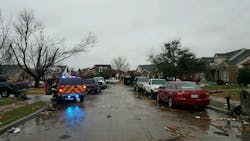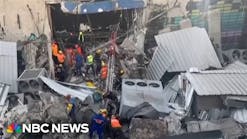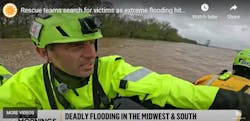Training Paid Off During Texas Tornado Response
Source Firehouse.com News
A Texas fire chief said training and relationships helped emergency crews respond to a tornado that damaged over 1,000 structures in his community the day after Christmas.
The deadly EF4 tornado ripped through Garland before moving northwest to Rowlett. It was on the ground for more than three miles with about half-mile wide path through the southwest quadrant of Rowlett, damaging over 1,100 homes and 30 businesses. About two dozen were injured.
Rowlett Fire Rescue Chief Neil Howard said three months earlier his department, along with local police and public works agencies, had a table-top exercise that simulated a tornado.
The twister took the same path as practiced in the drill.
“That is what is really eerie about this whole thing,” Howard, also the city’s emergency management director, recalled. “In our drill, the tornado took out a fire station and that station was less than a quarter-mile from the damaged area.”
One of his stations had already been dispatched with Garland fire crews to a grim scene on I-30 where winds picked up cars and threw them about. Several people died.
Rowlett Fire Rescue has four stations with four engines and three ambulances staffed.
As the storm blew through, Rowlett firefighters were dispatched to several incidents and that’s when crews began to realize the damage.
“Our first operational period was totally in the dark and in the pouring rain,” Howard said.
Realizing the severity of the damage, additional fire departments as well as Texas Task Force 1 and 2 USAR teams were requested to assist.
Regional resources from Task Force 2, including K9s, were on scene in short time and began searching debris piles for victims.
“We spent most of the night trying to get our arms wrapped around the situation... once daylight came Sunday, we could better see what we had to deal with.”
Howard stressed the importance of establishing a staging area for additional resources where they then could be dispatched.
“The blessing is that at one time in staging we had 10 ambulances and six to eight engines that we did not need to deploy,” Howard said of the mutual aid assets from approximately 25 fire departments.
By daybreak, both USAR task forces began using their advanced search and assessment skills at collapsed and damaged structures.
Firefighters searched the debris for any victims and then began checking on other hazards. After it was determined that nobody was missing, rescuers turned to recovery mode by removing debris from streets.
The city’s water tower had to be drained after it was found to be damaged by the tornado. Howard said crews enforced an evacuation around the tank and then cut valves to empty the tank.
Howard said his crews did not have “heroic rescues that you normally find in these situations.” He attributed that to the fact that the city sounded the tornado sirens four times. “I really think that made the difference.”
“One of the biggest takeaways from this incident was that my executive team and I have a great working relations,” the chief said, adding that his interactions with the police chief, head of public works, the financial manager and other department heads were beneficial.
“You need to build those relationships before you get to this position and or you will struggle when you are confronted by this type of situation.”
A week after the storm, Howard said his crews were primarily responding to gas leaks as utility crews and residents work on their homes.
None of the firefighters were displaced by the tornado, and no equipment or stations were damaged.
“There’s a lot on your plate and there’s a lot of stress to make sure everything is going properly,” Howard said after serving as incident commander for seven days.
The role of emergency manager added to the mix. “You’re normally focused on your employees and this was looking over everyone in the city. That’s a lot of people and lives.”






